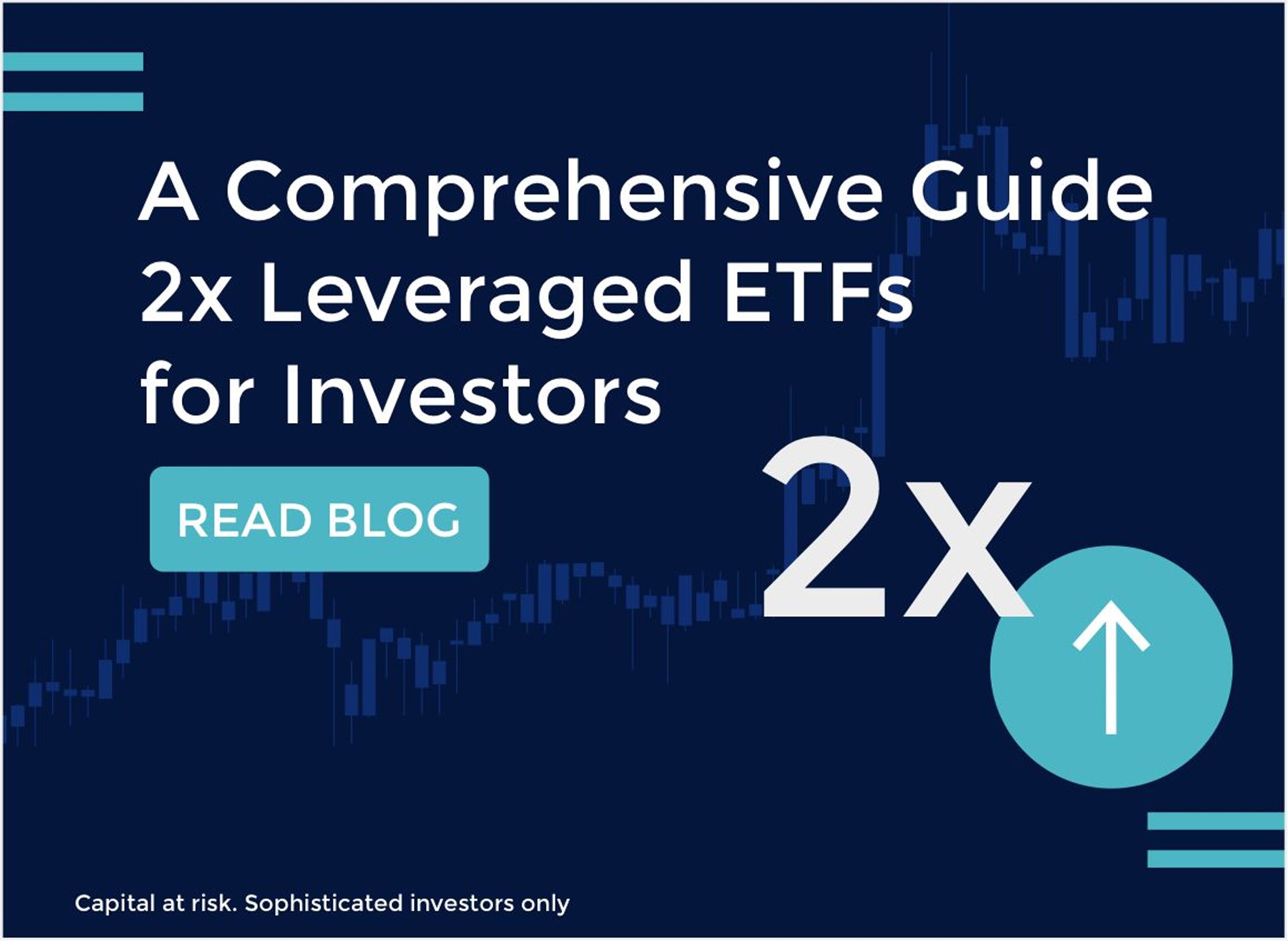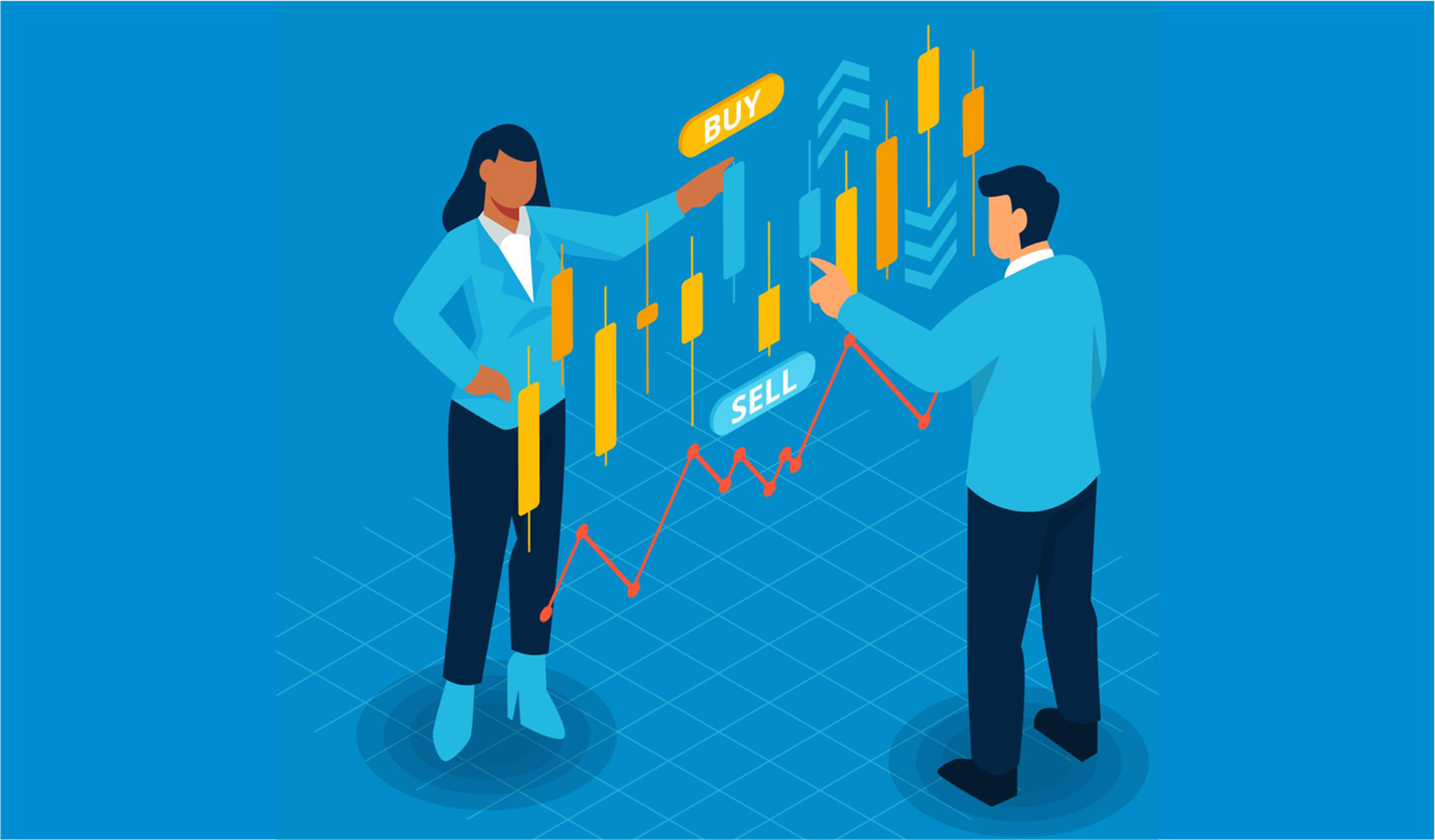A Comprehensive Guide to 2x Leveraged ETFs for Investors
Posted:
What are ETFs?
Exchange-Traded Funds (ETFs) are investment funds that are traded on stock exchanges, similar to stocks. ETFs hold assets such as stocks, commodities, or bonds and generally operate with an arbitrage mechanism designed to keep trading close to its net asset value, though deviations can occasionally occur. They offer investors a way to invest in a broad range of securities without having to buy each individual asset, providing diversification, liquidity, and lower fees compared to traditional mutual funds.
2x Leveraged ETF

A 2x leveraged ETF is an exchange-traded fund that aims to double the performance of a specific index, asset, or single stock – based on the daily percentage change of that underlying asset. This means that if the asset increases by 1%, the ETF will increase by 2%. On the other hand, if the asset goes down by 1%, then the leveraged ETF should go down by 2%.
These leveraged ETFs can be traded like regular stocks and are often used as a tool for investors looking for amplified returns in shorter periods. However, this comes with heightened risk and increased volatility, making this investment more suitable for experienced investors.
How 2x Leveraged ETFs Work
So, how do 2x leveraged ETFs work? How do they double the performance of the underlying index, stock, or asset class?
The answer lies in leverage as a key concept. This involves borrowing money to increase the investment size, allowing the leveraged ETF to double the gains or losses of the index.
Daily adjustments are made to maintain the 2x leverage. The ETF recalibrates its holdings daily to maintain the 2x leverage tied to the underlying asset, which can have compounding effects over time, increasing the risk/reward scenario associated with the ETF.
Pros and Cons of 2x Leveraged ETFs
2x Leveraged ETFs can appeal to some experienced investors if the potential benefits align with their insights and goals. Here are the pros and cons associated with 2x Leveraged ETFs.
Pros
Potential for Higher Returns: The ETF will deliver twice the daily performance of the underlying asset, giving you higher returns in a bullish period.
Ease of Use: Leveraged ETFs can be bought and sold like a stock in an exchange.
Cons
Higher Risk: The potential for higher returns also comes with heightened risk. The ETF will deliver twice the daily performance, which includes twice the losses if the index drops.
Volatility: The value of these ETFs can swing sharply daily, making them more suitable for experienced investors who can handle these swings and the inherent risk.
Decay: The performance of the ETF can drift from the underlying asset due to daily compounding, so it’s best to monitor these leveraged ETFs frequently while having a plan.
Understanding 2x Leveraged ETFs
Mechanics of Leveraged ETFs
2x leveraged ETFs aim to deliver twice the daily return of an underlying index through a combination of financial derivatives and debt. These funds rebalance their portfolios at the end of each trading day to maintain the 2x leverage ratio. This rebalancing process involves adjusting positions in futures, swaps, and other financial instruments to ensure the desired leverage is achieved.
This daily adjustment is crucial because it means that the 2x leverage effect applies strictly to daily returns. Over longer periods, the impact of compounding can cause the ETF's performance to deviate significantly from twice the return of the underlying index, especially in volatile markets.
Types and Applications
2x leveraged ETFs are available for various asset classes, including equities, sectors, commodities, and currencies. Equity-based leveraged ETFs might track broad market indices like the S&P 500, while sector-specific ETFs focus on areas like technology or healthcare.
Commodity and currency-leveraged ETFs provide exposure to underlying assets such as gold, oil, or foreign exchange rates. These ETFs are commonly used for short-term trading strategies, speculative investments, or hedging purposes. Their ability to magnify returns makes them attractive for traders looking to capitalize on short-term market movements, but the amplified risk also necessitates careful management and a clear understanding of the product's mechanics.
Popular 2x Leveraged ETFs
There are numerous popular 2x Leveraged ETFs on the market. Here are some examples of funds that aim to double the daily return of certain indexes, assets, or single stocks.
Leveraged Single Stock ETFs
Here are some 2x Leveraged ETFs that track popular single stocks like Apple, Nvidia, and Tesla:
- NVDL: GraniteShares 2x Long NVDA Daily ETF
- TSLR: GraniteShares 2x Long TSLA Daily ETF
- AAPB: GraniteShares 2x Long AAPL Daily ETF
Check out the full list of Leveraged Single Stock ETFs, including those mentioned above and others like AMZN, BABA, COIN, META, MSFT, and more.
Investment Strategies
Some trading strategies and investor profiles are better suited for buying and selling 2x Leveraged ETFs. Potential investors should take note of these characteristics and compare them with their own portfolio planning, goals, and risk tolerance.
Short-Term Trading Strategies

This strategy involves buying and selling 2x leveraged ETFs in short periods, anywhere from a few days to a few weeks. This is also sometimes referred to as swing trading, and it differs from the traditional “buy and hold” investment approach.
A combination of technical and fundamental analysis can help traders make educated decisions while detecting future pricing patterns and also keeping an eye out for any news that could impact those potential positions.
Risk Management Techniques
Understanding risk management and having a plan for it is crucial when investing in 2x Leveraged ETFs. This includes diversifying your overall portfolio and allocating a responsible position size that aligns with your overall strategy and risk tolerance.
Stop-loss orders can also protect investors from facing amplified losses, as they are used to automatically sell shares when they fall to a certain price level, which could be what you are willing to lose in this certain investment strategy.
Suitable Investor Profiles
As mentioned earlier, 2x Leveraged ETFs are best for experienced traders with a fair risk tolerance and a plan. These investors understand the overall market dynamics and the risk associated.
Investors that are beginners or have a somewhat conservative risk tolerance might find these ETFs too volatile for their comfort.
Practical Considerations
Investing in 2x leveraged ETFs demands constant vigilance. Monitoring and Rebalancing is essential because the daily reset can lead to performance deviations over longer periods. Investors should frequently review their positions to ensure they align with their investment objectives. Additionally, understanding the tax implications is crucial, as the short-term trading often associated with these ETFs can lead to higher tax liabilities.
Utilizing tax-efficient investing strategies can help mitigate this impact. Finally, leveraging available investor tools and resources, such as financial analysis platforms and educational materials, can enhance decision-making and risk management, ensuring that investors are well-informed and prepared for the unique challenges of leveraged ETFs.
Key Risks and How to Mitigate Them

These 2x Leveraged ETFs can be very volatile. Even small market movements can trigger substantial gains or losses. On top of that, daily resetting can compound these effects.
Because of this, investors should closely track these investments and consider using stop-loss orders to limit potential losses. The stop-loss orders should be set at a predetermined price while planning for the risk and investment size as a proportion of the overall portfolio.
It also makes sense to diversify your investments to spread risk while carefully planning the exposure of your portfolio.
Conclusion
Investing in a 2x Leveraged ETF requires careful consideration and planning to understand the risks involved. It’s important to have a strategy in mind that maps out the risks and rewards that come with this investment.
Even though 2x Leveraged ETFs offer potential high rewards, the other side of that carries enhanced losses if things move against you. For this reason, these investments need to be closely monitored with swift decision making.
Investors need to weigh their overall risk tolerance, understand the ups and downs associated with these leveraged ETFs, and have a clear plan before getting into these investments.
ETFs by GraniteShares
| Product name | Ticker | ||
|---|---|---|---|
|
US |
|||
Important Information
Investors should consider the investment objectives, risks, charges and expenses carefully before investing. For a prospectus or summary prospectus with this and other information about the Funds, please call (844) 476 8747 or visit www.graniteshares.com. Read the prospectus or summary prospectus carefully before investing.
The investment program of the funds is speculative, entails substantial risks and include asset classes and investment techniques not employed by more traditional mutual funds.
PRINCIPAL FUND RISKS (see the Prospectus for more information)
The Fund is not suitable for all investors. The investment program of the funds is speculative, entails substantial risks and includes asset classes and investment techniques not employed by most other ETFs and mutual funds. Investments in the ETFs are not bank deposits and are not insured or guaranteed by the Federal Deposit Insurance Corporation or any other government agency. The Fund is designed to be utilized only by knowledgeable investors who understand the potential consequences of seeking daily leveraged (2X) investment results, understand the risks associated with the use of leveraged exposure and are willing to monitor their portfolios frequently. For periods longer than a single day, the Fund will lose money if the Underlying Stock’s performance is flat, and it is possible that the Fund will lose money even if the Underlying Stock’s performance leveraged over a period longer than a single day. An investor could lose the full principal value of his/her investment within a single day.
The Fund seeks daily leveraged investment results and are intended to be used as short-term trading vehicles. This Fund attempts to provide daily investment results that correspond to the respective leveraged of the performance of its underlying stock (a leveraged Fund).
Investors should note that the fund pursues daily leveraged investment objectives, which means that the fund is riskier than alternatives that do not use leverage because the fund magnifies the performance of their underlying security. The volatility of the underlying security may affect a Fund’s return as much as, or more than, the return of the underlying security.
Because of daily rebalancing and the compounding of each day’s return over time, the return of the Fund for periods longer than a single day will be the result of each day’s returns compounded over the period, which will very likely differ from 200% of the return of the Underlying Stock over the same period. The Fund will lose money if the Underlying Stock’s performance is flat over time, and as a result of daily rebalancing, the Underlying Stock volatility and the effects of compounding, it is even possible that the Fund will lose money over time while the Underlying Stock's performance increases over a period longer than a single day.
An investment in the Fund involves risk, including the possible loss of principal. The Fund is non-diversified and includes risks associated with the Fund concentrating its investments in a particular industry, sector, or geographic region which can result in increased volatility. The use of derivatives such as futures contracts and swaps are subject to market risks that may cause their price to fluctuate over time. Risks of the Fund include effects of Compounding and Market Volatility Risk, Inverse Risk, Market Risk, Counterparty Risk, Rebalancing Risk, Intra-Day Investment Risk, Daily Index Correlation Risk, Other Investment Companies (including ETFs) Risk, and risks specific to the securities of the Underlying Stock and the sector in which it operates. These and other risks can be found in the prospectus.
This information is not an offer to sell or a solicitation of an offer to buy shares of any Funds to any person in any jurisdiction in which an offer, solicitation, purchase or sale would be unlawful under the securities laws of such jurisdiction.
THE FUNDS AREDISTRIBUTED BY ALPS DISTRIBIUTORS, INC. GRANITESHRES IS NOT AFFILIATED WITH ALPS DISTRIBUTORS, INC


